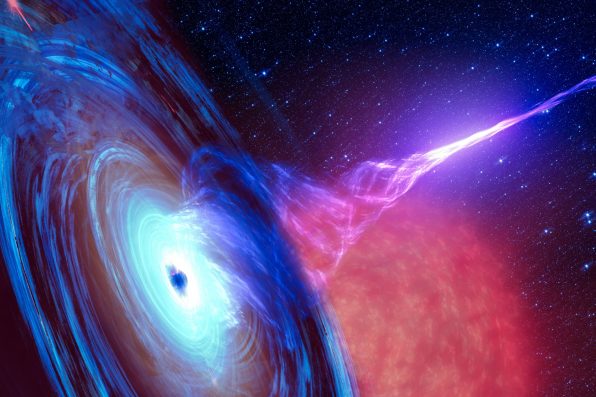A Supermassive Black Hole In The Early Universe Is Starving Its Galaxy To Death By Cutting Off The Food It Needs To Form New Stars

Astronomers have witnessed a supermassive black hole in the early universe that is starving its galaxy to death.
The observation was made through the James Webb Space Telescope (JWST). The galactic death appears to have progressed quickly due to winds of gas blowing at two million miles per hour.
A galaxy is considered dead when its star formation is cut off. This can happen if the dense clouds of gas and dust, which are the foundation of stars, are exhausted.
For a long time, scientists have thought that galaxies can be “killed” prematurely when their central supermassive black holes expel gas and dust from them.
The JWST observations are the first solid pieces of evidence that confirm how star formation is prevented by galaxies being starved.
A team of researchers came to this conclusion after studying the early galaxy named “Pablo’s Galaxy.” It is officially known as GS-10578.
Pablo’s galaxy is named after the team member who suggested that it should be observed in detail. It is located around 11.5 billion light years away.
“Based on earlier observations, we knew this galaxy was in a quenched state: it’s not forming many stars given its size, and we expect there is a link between the black hole and the end of star formation,” said Francesco D’Eugenio, a team member from the Kavli Institute for Cosmology at the University of Cambridge.
“However, until the JWST, we haven’t been able to study this galaxy in enough detail to confirm that link, and we haven’t known whether this quenched state is temporary or permanent.”

elen31 – stock.adobe.com – illustrative purposes only
The galaxy is roughly the size of the Milky Way and has a mass 200 billion times that of the sun. Between 12.5 billion and 11.5 billion years ago, it birthed most of its stars. It is also unusually massive for this particular time period in the early universe.
Most galaxies in the early universe are forming lots of stars, so the death of Pablo’s galaxy is out of the ordinary.
According to Roberto Maiolino, also from the Kavli Institute of Cosmology, the process that stopped its star formation must’ve happened fairly quickly because it still had enough time to reach such a massive size before then.
The team used the JWST to determine that the supermassive black hole at the heart of Pablo’s galaxy was ejecting large amounts of gas at speeds of up to 2.2 million miles per hour.
The significant speed is enough to beat the galaxy’s gravitational influence and allow the gas and dust to escape.
The winds of Pablo’s galaxy have a dense gas component that is cooler and denser than those of many other galaxies.
The JWST detected the dense gas stream because it was blocking light from galaxies behind it. The mass of the gas stream from Pablo’s galaxy was greater than the gas that is required for new star formation.
“We found the culprit,” D’Eugenio said. “The black hole is killing this galaxy and keeping it dormant by cutting off the source of ‘food’ the galaxy needs to form new stars.”
Next, the team plans to conduct an investigation using the Atacama Large Millimeter-Submillimeter Array (ALMA). It consists of 66 radio telescopes based in northern Chile. It could reveal gas remains in Pablo’s galaxy.
The study was published in Nature Astronomy.
Sign up for Chip Chick’s newsletter and get stories like this delivered to your inbox.
More About:News





